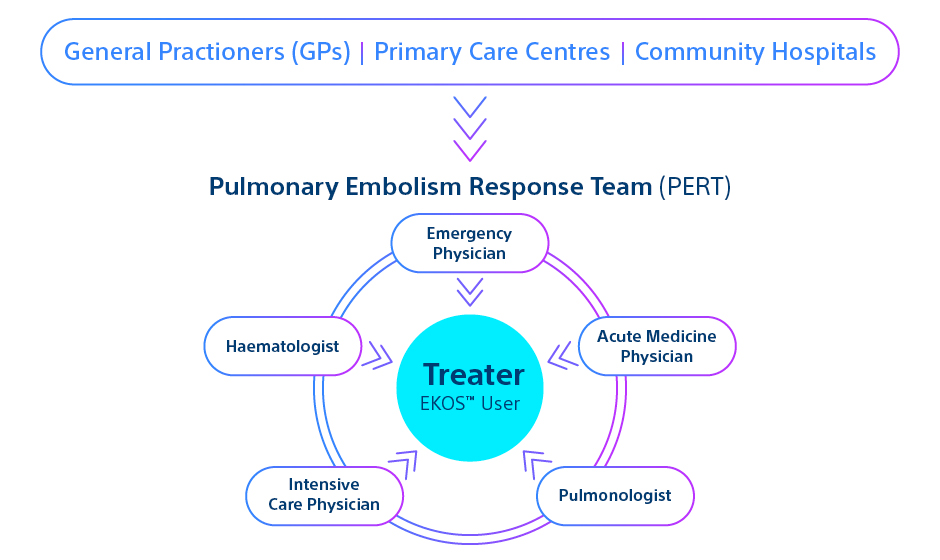Establishing a Pulmonary Embolism Response Team (PERT)
The high degree of variability in patient presentation and outcome from Pulmonary Embolism makes it a disease process that requires a multidisciplinary approach. In order to facilitate a rapid, robust response to the diagnosis of pulmonary embolism, it is important to establish a multidisciplinary Pulmonary Embolism Response Team (PERT) that allows for shared ownership of the PE pathway.
The PERT model is based on existing multidisciplinary teams such as heart teams and rapid response teams. A PERT is composed of clinicians from the range of specialities involved in the treatment of PE, including emergency, intensive care unit (ICU), interventional cardiology, radiology, pulmonology, acute medicine and haematology, among others.

*Treater (EKOS User): Clinicians treating with EKOS are typically interventional cardiologists, interventional radiologists, cardiothoracic, cardiovascular or vascular surgeons.
A PERT serves as a 24/7 consult service that is able to provide expert advice on the initial management of PE patients and convene in real time to develop a consensus treatment plan specifically tailored to the needs of a particular patient and consistent with the capabilities of the institution.1
Why is PERT approach important?
Acute Pulmonary Embolism is a common, potentially life-threatening disease.2 In patients with acute Pulmonary Embolism, the risk of death is particularly high in the first days and then declines over time.3
Multidisciplinary Pulmonary Embolism Response Teams have two primary goals:
- Enable earlier diagnosis of intermediate-high and high-risk pulmonary patients.
- Reduce variations in practice and develop standardized protocols of care.
Professor Laurent Bonello, Head of ICU and PERT Team at the University Hospital Nord Marseille, France, talks about why it’s taken so long to improve standards of PE treatment, and the challenges involved in building a PERT.
Dr Nick Murch, Consultant Physician in Acute Medicine, Royal Free London, UK, discusses the challenges in diagnosing Pulmonary Embolism, and what PERT can bring to building the right pathway for patients.

Explore the Pulmonary Embolism Blended Learning Path on EDUCARE
Boston Scientific has developed an exclusive Pulmonary Embolism blended learning program with a team of well-known experts who are passionate about improving care for patients with PE.
For existing EDUCARE users, access directly the full content >
Still an unregistered user? Get an overview of the course to see what awaits you >
Convinced? Proceed with EDUCARE registration by following the instructions depicted in this guide >
References:
1. Root, C.W., et al. “Multidisciplinary approach to the management of pulmonary embolism patients: The pulmonary embolism response team (PERT)”. J Multidiscip Healthc, 2018; 11: 187-95.
2. Goldhaber SZ, Visani L, De Rosa M, « Acute pulmonary embolism: clinical outcome in the International Cooperative Pulmonary Embolism Registry. » Lancet 1999; 353: 1386–1389.
3. Heit JA, Silverstein MD, Mohr DN, et al., « Predictors of survival after deep vein thrombosis and pulmonary embolism: a population-based, cohort study. » Arch Intern Med 1999; 159: 445–453.
Caution:
The law restricts these devices to sale by or on the order of a physician. Indications, contraindications, warnings, and instructions for use can be found in the product labelling supplied with each device or at www.IFU-BSCI.com. Products shown for INFORMATION purposes only and may not be approved or for sale in certain countries. This material not intended for use in France.
















